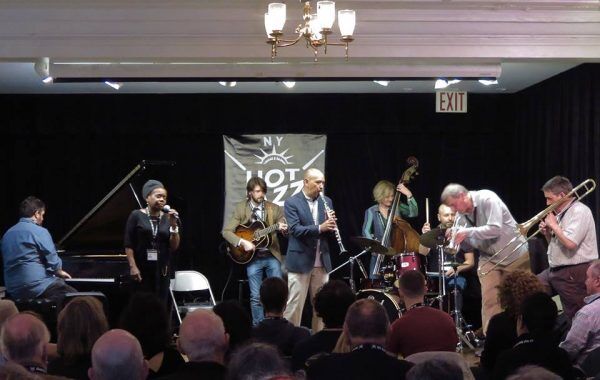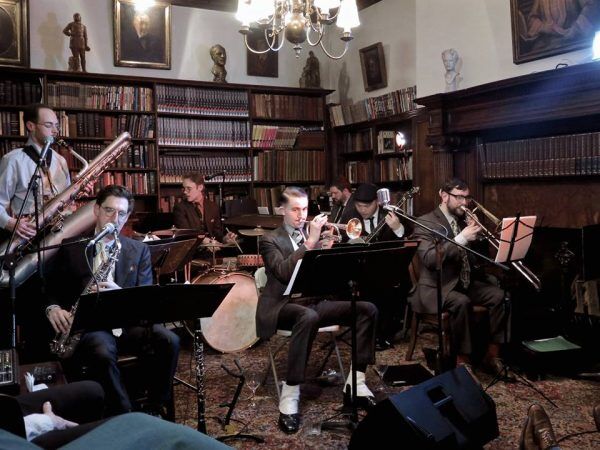The 3rd annual New York Hot Jazz Camp, which took place during the first week in April, culminated in the Gotham Jazz Festival from noon on Sunday, April 8 until 1 am Monday, with only a hiatus from 5:15 to 6:30, during which time the venue was closed. Everyone, including people who had bought full-day tickets, had to leave, then wait in line to re-enter the building. The Festival was held at the Players Club, a historic mansion on East 20th Street facing Gramercy Park, and is run by Patrick Soluri’s Prohibition Productions. Patrick is a drummer who attended last year’s Camp. He produces a number of jazz and swing events throughout the year at various venues, mostly in Manhattan.
The festival occupies three rooms at the Club: the ballroom and Kinstler Room on the first floor, and the library on the second floor. The ballroom accommodates the largest crowd and has a dance floor, which saw much use during most sets. The solo pianists played in the Kinstler room, which had ample space for the number of patrons who attended. Unfortunately, at times the sound from the larger ensembles in the ballroom filtered into Kinstler, detracting from the experience. There is one room between the two, where a bar and the merchandise sales table were set up. That also contributed to the noise interference. This issue also occurred in previous Hot Jazz Festivals that were held at the Players Club.
Patrons who bought VIP tickets were guaranteed seats in the ballroom, but during most of the time I was there, at least a third of the reserved seats were empty. This forced everyone else to stand if they could not secure one of the relatively few chairs that lined the walls facing the dance floor. This also hampered their view of the stage. The seating situation was better in Kinstler, as it featured comfortable lounge chairs or sofas, and there were steps to sit on for those not able to snag one of the plush seats. This room also faced the street, so it had windows that could be opened to relieve the warmth and stuffiness that plagued the other two venues as the day wore on due to the large crowd. The library, being on the second floor, suffered from the natural rising of heat, and it’s not a large room to begin with. The last band to play there, Mike Davis’s New Wonders, had to endure the worst of it. The only thing hotter was their music!

I believe the relative scarcity of seats was intentional, to encourage patrons to wander between venues. There were many choices of ensembles and pianists to take in—too many, in my opinion. Having worked at camp, I wanted to not miss any of the six camper bands’ sets, to see the results of their four days of practice and mentoring from the world-class faculty. The faculty also played a 75-minute set to wrap up the afternoon. That meant I was unable to catch a number of the ensembles on the program: Xylopholks, Stephane Wrembel, the Hot Toddies, Hannah Gill and the After Hours Jazz Band, Jon-Erik Kellso’s Ear-Regulars (with vocalist Kat Edmonson), and pianists John Dimartino, Jesse Gelber, and Spike Wilner.
I have never liked moving from one band to another in mid-set; I much prefer to hear one band’s set in its entirety in order to get a much fuller impression of the group. So in this case, to me at least, the whole is not more than the sum of the parts. I had painstakingly mapped out my schedule for the day before the first notes sounded, trying to maximize the number of groups I could hear while giving each a fair amount of time. Some of the groups were new to me and I made an effort to catch them, but not at the expense of seeing the camp ensembles. The only event that did not compete with any other was the late night jam, from 11:45 until a little after 1, at which some of the evening’s performers sat in.
The groups that I did get to hear were Cynthia Sayer’s trio, the Louis Armstrong Eternity Band led by David Ostwald, Adrien Chevalier’s Gypsy Jazz Quartet, Gordon Webster and Friends (essentially, his NYC Lindy Hop band), the aforementioned New Wonders, and pianist Daryl Sherman. There was only one band I did not like: King Solomon Hicks. I had never heard of them, but I saw two of their performances in one: my first and my last. It sounded like a rock band, and three minutes was all I could take. But they packed the ballroom and the dance floor.

Now, about the Camp. It was founded and is run by trumpeter and vocalist Bria Skonberg and vocalist/guitarist Molly Ryan, and was the subject of my very first column in this paper in June 2016. I have been a volunteer at Camp each year and have found it to be a very exhausting yet rewarding experience. These two bright and talented young women, having both attended music camps as teenagers, are repaying the jazz community for the benefits they reaped from their camp experiences. Indeed, Bria is now on the faculty of the Sacramento Youth Jazz Camp.
As would be expected, the campers—there were 44 this time—arrive with a wide range of experience. A few have attended each year, a few others had come one previous year. Several had attended other camps, such as Banu Gibson’s in New Orleans, or one of those on the West Coast. But each camper leaves at a higher level than when they entered, so in that respect the Camp fulfills its mission. Several campers from the New York area, while not leading bands of their own and not full-time musicians, are often found sitting in with top-drawer pros around the city.
At the outset, campers were placed into ensembles that were given original names, such as “The Mighty Gothalayans,” “Christopher Street Five (under the tutelage of Evan Christopher),” and “Barrow Street Brawlers” (the camp site, the Greenwich House Music School, is located on Barrow Street). Each band was overseen by one or two faculty members, but in most cases the selections on Sunday were actually led by one of the students. They played sets of three tunes each, including one vocal. These sets ran from 12:30 to 2:30 in the ballroom, followed by an hour-long set by the vocal students in Kinstler directed by Catherine Russell, their instructor.
The other faculty members were Evan Christopher, reeds; Randy Reinhart, trumpet; Jim Fryer, trombone; Dalton Ridenhour, piano; Rob Garcia, drums; Nicki Parrott, bass; and Justin Poindexter, guitar and banjo. Bria led one of the groups on stage, but other than playing along when she had the time during camp, she was not part of the faculty. She and Molly also emceed most of the sets during the festival and participated in the faculty’s set.
Camp ran from 10 am to 5 pm on Tuesday through Friday. Unlike previous years, when after-school jams were held in nearby venues such as Fat Cat, this year they took place on the premises. New York City schools were closed for vacation that week, so there were no classes at the GHMS. The move from May to early April was a wise one, if for no other reason than the weather is cooler. That made it easier on us volunteers who had to go up and down the four sets of stairs more times than we could count (one volunteer had a watch that records movement, but I neglected to ask him how many steps he had taken), or go out to a nearby store for last-minute supplies.
On two days, there were one-hour lectures after lunch. One was by Sherrie Maricle, a drummer who leads one of the first all-female bands, Diva. She recounted the resistance and harassment she endured at a time when women musicians, much less bandleaders, were not regarded seriously. The other lecture was titled “From Louis to Ella” by Will Friedwald, the author of several books on jazz and jazz musicians and a regular columnist for The Wall Street Journal. I was not scheduled to work that day, but I came in specifically to hear him, and was not disappointed. On Saturday there was a bus trip to the Louis Armstrong House Museum, where Bria has volunteered and where one of the campers, Dave Dilzell, is a docent. I did not participate in this, as I had two symphony concerts to attend back home. I had been to the Museum before.
In addition to my long-standing friendships with Molly and Bria, I know most of the instructors—the roster changes a little each year in order to provide the students with a wider range of styles and techniques—and have gotten to know a number of campers. So New York Hot Jazz Camp has become a sort of old home week for me. I plan to volunteer again next year.
Bill Hoffman is a travel writer, an avid jazz fan and a supporter of musicians keeping traditional jazz alive in performance. He is the concert booker for the Tri-State Jazz Society in greater Philadelphia. Bill lives in Lancaster, PA. He is the author of Going Dutch: A Visitors Guide to the Pennsylvania Dutch Country, Unique and Unusual Places in the Mid-Atlantic Region, and The New York Bicycle Touring Guide. Bill lives in Lancaster, PA.






















